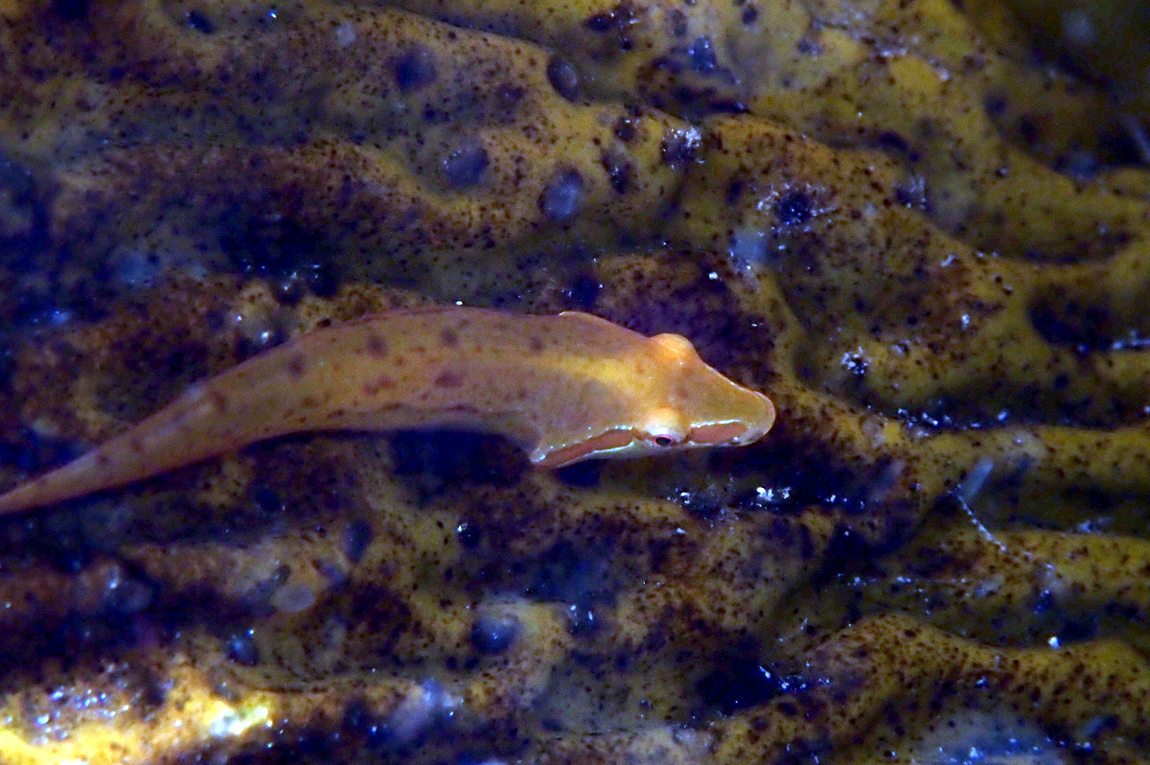Longsnout Clingfish, Parvicrepis sp 1
Other Names: Long-snout Clingfish

A Longsnout Clingfish, Parvicrepis sp. 1, on Port Noarlunga Reef, Gulf St Vincent, South Australia, January 2022. Source: Matt Tank / iNaturalist.org. License: CC by Attribution-NonCommercial
Summary:
A bright to dark green, yellowish to pale brown clingfish with a row of darker spots along the middle of the back, occasionally dark elongate blotches on the back and sides, and often a dark stripe on each side of the snout, through eyes to the margin of the preoperculum. The snout is usually longer than wide.
Cite this page as:
Bray, D.J. 2022, Parvicrepis sp 1 in Fishes of Australia, accessed 24 Apr 2024, https://fishesofaustralia.net.au/Home/species/5449
Longsnout Clingfish, Parvicrepis sp 1
More Info
|
Distribution |
Southern Australia, from eastern Victoria, to the Perth region, Western Australia, and around Tasmania. Inhabits seagrass beds and shallow algal-covered reefs. |
|
Features |
Dorsal fin 4-6; Anal fin 4-6; Caudal fin (approx) 10-12; Pectoral fin 20-22; Pelvic fin I, 4; Vertebrae 40-42. Body moderately elongate, of moderate breadth; caudal peduncle prominent. Head only slightly flattened; snout generally longer than wide, rounded at tip; eyes of moderate size; lips narrow; mouth small, reaching to below front part of eyes, lower jaw slightly shorter than upper; teeth small, conical; no spine laterally on head; gill openings large, lateral. No scales or lateral line; some sensory papillae on sides. Single dorsal fin with very short base, located posteriorly on body but separated from caudal fin by space twice length of dorsal fin base; anal fin similar to and opposite dorsal, anterior rays of dorsal fin prominently swollen at base; caudal fin rounded. Pectoral fins rounded, no fleshy pad ventrally at their bases. Pelvic fins united into a rather small ventral sucking disc consisting of anterior and posterior halves, posterior border with row of small rounded flaps of tissue. Urogenital papilla usually laid flat in post anal groove in preserved males. |
|
Colour |
Apple green or dark green to pale brown with row of darker spots along midline of back; occasionally with dark elongate blotches on back and sides; dark stripe often on each side of snout, through eyes to preopercular margins. |
|
Author |
Bray, D.J. 2022 |
Longsnout Clingfish, Parvicrepis sp 1
References
Hutchins, J.B. 1994. Family Gobiesocidae, in Gomon, M.F., Glover, C.J.M. & Kuiter, R.H. (eds) The Fishes of Australia's South Coast. State Print, Adelaide. 992 pp.
Hutchins, J.B. 2008. Family Gobiesocidae. pp. 722-741 in Gomon. M.F., Bray, D.J. & Kuiter, R.H (eds) Fishes of Australia's Southern Coast. Sydney : Reed New Holland 928 pp.
Kuiter, R. & Kuiter, S. 2018. Coastal sea-fishes of south-eastern Australia. Seaford, Victoria : Aquatic Photographics, 371 pp.
Whisson, G. & Hoschke, A. 2021. The Perth coast fish book. Perth, Western Australia : Aqua Research and Monitoring Services, 288 pp. (as Undescribed Clingfish - top image)




